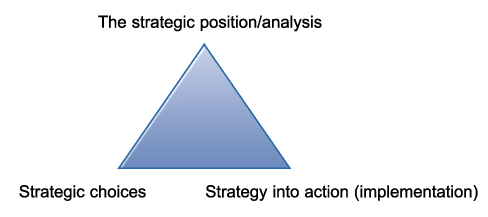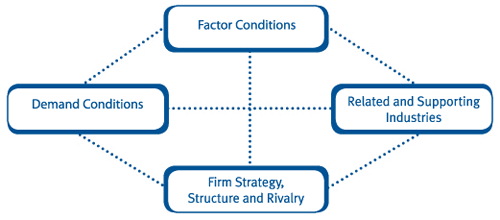Strategic analysis
Strategic analysis is a key step within the strategic planning process:

The strategic position / strategic analysis
Assessing the strategic position consists of analysing:
- the environment (competitors, markets, regulations, discoveries etc). Key factors are often summarised as opportunities and threats.
- the strategic capability of the organisation (resources, competences). Key factors are often summarised as strengths and weaknesses)
- the culture, beliefs and assumptions of the organisation
- the expectation and power of stakeholders (what do the shareholders want? Will employees co-operate?).
The external environment
Since strategy is concerned with the position a business takes in relation to its environment, an understanding of the environment's effects on an organisation is of central importance to strategic analysis. The historical and environmental effects on the business must be considered, as well as the present effects and the expected changes in environmental variables.This is a major task because the range of environmental variables is so great. Many of those variables will give rise to opportunities of some sort, and many will exert threats upon the organisation.
The two main problems that have to be faced are, first, to distil out of this complexity a view of the main or overall environmental impacts for the purpose of strategic choice; and second, the fact that the range of variables is likely to be so great that it may not be possible or realistic to identify and analyse each one.
The resources of the organisation
There are internal influences as well as outside influences on the firm and its choice of strategies. One of the ways of thinking about the strategic capability of an organisation is to consider its strengths and weaknesses (what it is good or not so good at doing, or where it is at a competitive advantage or disadvantage, for example). Considering the resource areas of a business such as its physical plant, its management, its financial structure and its products may identify these strengths and weaknesses.
Again, the aim is to form a view of the internal influences and constraints on strategic choice. The expectations of different stakeholders are important because they will affect what will be seen as acceptable in terms of the strategies advanced by management. However,the beliefs and assumptions that make up the culture of an organisation, though less explicit, will also have an important influence.
Expectations and influence of stakeholders
A stakeholder can be defined as someone who has an interest in the well-being of the organisation. A typical list of stakeholders for a large company would include shareholders, employees, managers, customers, locality,suppliers, government and society at large.
Strategic planning and management cannot be achieved without regard to stakeholders.
- In a profit-making organisation, management might have a choice of adopting a high risk/high return strategy or a low risk/low return strategy. It's important to know which the shareholders want.
- In a not-for-profit organisation, such as a hospital, managers need to know what the government and potential patients want. How much resource should go into heart operations, how much into hip replacement, etc.
The beliefs and assumptions within an organisation
Culture affects the interpretation of the environmental and resource influences; so two groups of managers, perhaps working in different divisions of an organisation, may come to different conclusions about strategy, although they are faced with similar environmental and resource implications.
Which influence prevails is likely to depend on which group has the greater power, and understanding this can be of great importance in recognising why an organisation follows, or is likely to follow, the strategy it does.
A consideration of all relevant features
A consideration of the environment, resources, expectations and objectives within the cultural and political framework of the organisation provides the basis for strategic analysis of that organisation.
However, to understand its strategic position, it is also necessary to examine the extent to which the direction and implications of the current strategy and objectives that it is following are in line with, and can cope with, the implications of the strategic analysis.
Key strategic models
A number of models have been developed to help with strategic analysis
SWOT analysis
A SWOT analysis can be used as an analysis tool in its own right or can be used as a summary sheet on which other results can be placed.
- Strengths and weaknesses relate to resources and capabilities: what is the organisation good at? What is it poor at? Where are resources in short supply? Where are resources excellent?
- Opportunities and strengths relate to external factors: what will the effect on the organisation be of economic changes? Can the organisation make use of new technologies? Are new entrants likely to enter the market place? Can a powerful customer dictate terms?
External environmental analysis
As well as thinking in terms of opportunities and threats, the following tools can be used to analyse the external environment:
PEST analysis
A PEST analysis looks at the environment under the headings
- Political / legal factors
- Economic factors
- Social / cultural factors
- technological factors
A PEST analysis is particularly useful for identifying the drivers of change to identify growth opportunities and sources of risk.
Porter's five forces model
Just because a market is growing, it does not necessarily mean that a firm can be profitable in that market. Porter identified five forces that, collectively, determine the profit potential in an industry:
- competitive rivalry
- threat of new entrants
- threat from substitutes
- power of customers
- power of suppliers
Porter's diamond model
Porter tried to answer the following questions:
- Why does a nation become the home base for successful international competitors in an industry?
- Why are firms based in a particular nation able to create and sustain competitive advantage against the world's best competitors in a particular field?
- Why is one country often the home of so many of an industry's world leaders?
Porter called the answers to these questions the determinants of national competitive advantage. He suggested that there are four main factors which determine national competitive advantage and expressed them in the form of a diamond.

Internal analysis
As well as considering strengths and weaknesses, managers can use the following models to focus their attention.
Porter's value chain
Porter developed the value chain to help identify which activities within the firm were contributing to a competitive advantage and which were not.
The approach involves breaking down the firm into five 'primary' and four 'support' activities, and then looking at each to see if they give a cost advantage or quality advantage.
Critical success factors and core competencies
When considering strengths and weaknesses it is important to match these to the critical success factors (CSFs) in the industry - are our strengths the same as the ones necessary for success? In particular, if a business can obtain unique resources and core competencies that meet the CSFs in a market, then this should lead to its success
Product lifecycle analysis
Managers need to consider the whole product portfolio. For example, if all products are in the decline phase then the company may not have much of a future unless it develops new products quickly.
The Ms model
As a memory jogger, managers could assess strengths and weaknesses under the following headings:
- money - e.g. cash flow
- management - e.g. does the board of a small family company have the necessary skills?
- manpower - e.g. is there a problem retaining good staff?
- manufacturing - e.g. how does our quality compare to rivals?
- markets - e.g. do we have new product development in key markets?
- materials - e.g. are we sourcing quality components at a competitive price?
- make-up - e.g. do we have excessive costs due to bureaucracy?
|
Created at 10/11/2012 2:55 PM by System Account
(GMT) Greenwich Mean Time : Dublin, Edinburgh, Lisbon, London
|
Last modified at 9/11/2013 11:30 AM by System Account
(GMT) Greenwich Mean Time : Dublin, Edinburgh, Lisbon, London
|
|
|
|
 |
Rating
:
|
 Ratings & Comments
(Click the stars to rate the page) Ratings & Comments
(Click the stars to rate the page)
|
 |
Tags:
|
|
|
|
|